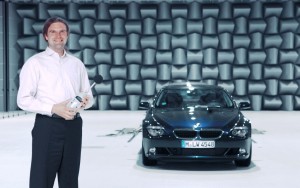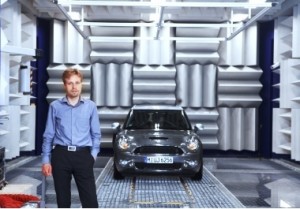BMW is using a 635d model, d for diesel, to demonstrate that electronic noise cancellation can be used instead of heavier materials to decrease the noise created by the compression ignition engine.
At the same time, engineers claim that they can tune the sounds that remain to give them a more pleasing character.
While active noise cancellation is not a new technology, Japanese makers have it in production, the urgent need to reduce the weight of fuel guzzling automobiles to meet increasingly stringent economy and CO2 emission regulations is bringing a new urgency to the search for more applications of existing techniques.
BMW claims that the sporty performance characteristics of its diesel engines and their high torque, especially when starting up and accelerating are contradicted by the “acoustic sensation” of diesel vehicles.
In a diesel, harsh ignition impulses during combustion are responsible for their characteristic noises — commonly called clatter or knocking. Already, makers of diesel cars are using various passive deadening techniques to isolate the sound from passengers, and sometimes outsiders. The problem is that heavier materials, starting with the engine block and cylinder head provide better attenuation. As makers reduce weight, they often add it back with insulation or sprayed on materials.
As with all automotive electronic technology, the calibration of a noise cancellation system is crucial. Too much sound with too little engine power creates a negative impression. German makers in particular were skeptical when Toyota’s Lexus luxury brand debuted with the lowest sound levels by far in the class, complaining that it was too quiet. The Lexus proposition was simple – the sound of luxury and quality is nothing, or as close to nothing as you can get. Given the sales success at Lexus, they are no longer scoffing.
“Even small changes to vehicle sound can have a big impact, since human hearing subconsciously evaluates acoustic surroundings like a high-performance analyzer and all changes are continuously registered in the brain,” said Dr. Alfred Zeitler, an acoustic psychologist at BMW.
BMW claims the test 635d is sound optimized by means of sound design and has its own very dynamic audio character. The noise typical for diesel vehicles disappears and instead, the driver hears a “sporty, superior sound.”
Unlike traditional engine noise attenuation, which targets specific intake or exhaust system frequencies, BMW is working on the entire rpm range and varying the acoustic results.
BMW’s work here is not new. In a Mini prototype demonstrated in 2009, a four-cylinder engine was made to sound like a powerful V8 engine or smooth straight-six engine.


